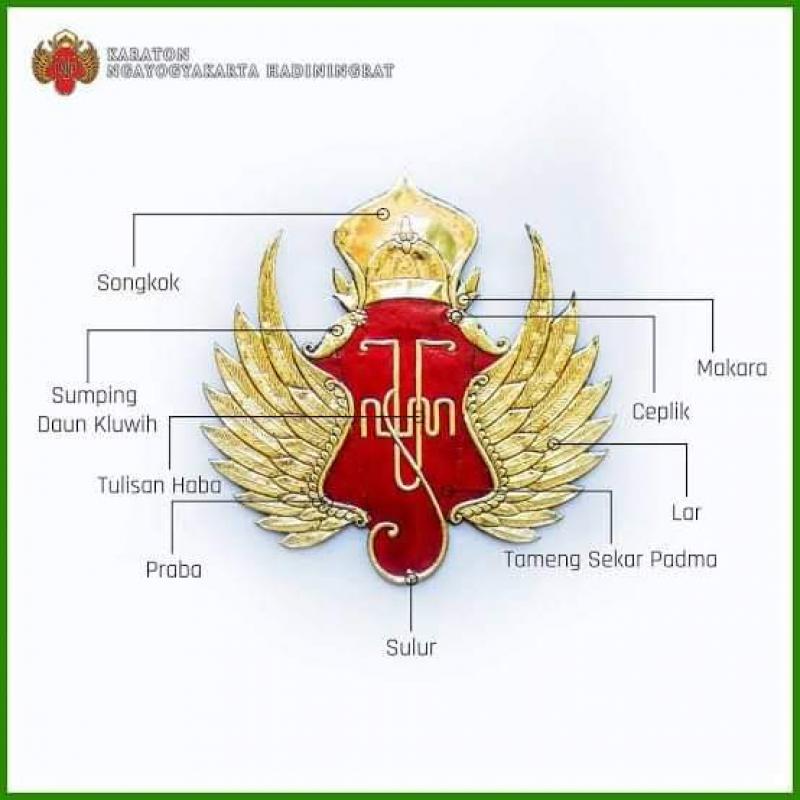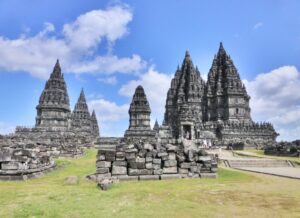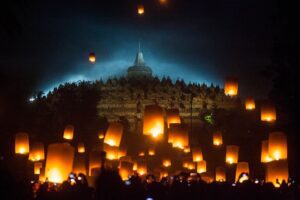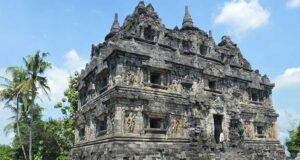Yogyakarta Palace that still exists today is the Kraton of Yogyakarta. Its cultural component is still intact, and the royal government’s organizational framework hasn’t changed over time either.
Because he provides for the community, the Sultan is vital to Kraton life. It should come as no surprise that the Special Autonomy Law designates the reigning king to serve as this region’s governor.
The Mataram society regards symbols or emblems in high respect that are held by the Kraton of Yogyakarta. These emblems, which point to the prosperity and splendor of the Kraton, are rich in philosophical meaning. The Praja Cihna is the name of the insignia.
Yogyakarta Palace Logo: Praja Cihna
Praja Cihna is a symbol of a nation or kingdom that combines a number of qualities with deep philosophical significance.
The traits of a king or the knightly character are represented by the crown (songkok). The earpiece or pendant worn above the ears is a symbol of defense for the Kraton’s well-being.
The beam of light, or praba, represents Mataram, the Javanese honor code. Wings (lar) represent high goals. The shield represents bravery in the face of truth-seeking vigilance.
Sultan Hamengku Buwono, the ruler of the Sultanate of Yogyakarta, is abbreviated as “Ha”-“Ba” in Javanese script.
The Padma flower, or sekar padma, represents the material existence that underlies the afterlife. The vine (laler) represents unceasing life, much like a vine that never stops growing and spreading.
Read more: The Role of the Yogyakarta Palace in Preserving Javanese Culture and Arts
The Symbol of Sultanate
In addition to representing the Sultanate of Yogyakarta, Praja Cihna is also the personal insignia of the Sultan, who is subsequently known as Cihnaning Pribadi.
This kind of Praja Cihna is used on building decorations, handicrafts, and even the king’s dining utensils. It serves as a symbol of the current monarch.
The embryonic form of Praja Cihna, which closely matches its current shape, was recognized from the wall decorations of Bangsal Manis, the Yogyakarta Kraton, either as a sign of the sultanate or the personal emblem of the Sultan.
A sengkalan inscription on this Praja Cihna says, “kaluwihaning yaksa salira aji.” Tree branches from the kluwih tree are carved to symbolize “Kaluwihaning” (1); kemamang carvings signify “yaksa”
Yogyakarta Palace Logo Meanings
The Praja Cihna, the Sultanate’s emblem, is housed in Yogyakarta’s Royal Palace, or Karaton Ngayogyakarta Hadiningrat.
In addition to being used as ornamental elements on a number of structures, Praja Cihna can be found on prize medals and official letterheads. The following are the meanings associated with this emblem:

1. Songkok (Crown)
It stands for the attitude of a fighter. It represents the Ruler’s personal emblem and his knightly identity.
2. Sumping (Ear Ornament)
It represents jewelry on the ears. A tiny, all-encompassing decoration that looks like a flower’s petals.
Kluwih leaves are named after the word “luwih,” which denotes excess or profusion. Makara, a symbol of defense for the Kraton’s security.
3. Praba (Beam of Light)
It presents the picture of a person who is respected for their honesty in preserving Javanese Mataram customs.
represents a person capable of preserving Javanese Mataram’s honor.
4. Lar (Wings)
It represents aspirations that are as high as the sky and aim towards the stars.
5. Tameng (Shield)
A tool for self-defense during combat. The color red represents bravery without sacrificing alertness in the pursuit of defending the truth.
6. Seratan Ha Ba (Ha Ba Inscription)
The Sovereign’s symbol, honoring individuals who have attained Hamengku Buwono’s degree of achievement.
This term, which encompasses lordship, sovereignty, and mastery, represents the greatness of the king. The Great Creator is represented by the color black.
The Javanese characters ‘Ha’ and ‘Ba’ represent the title of the reigning Sultan in Yogyakarta Palace, respectively.
The lofty goals expressed in this title are to safeguard, uphold, and ensure the prosperity of the people. Magnificence is symbolized by the color gold.
Read more: 10 Yogyakarta Palace Traditional Ceremonies and Traditions: Caring for Javanese Cultural Heritage
7. Kembang Sekar Padma (Padma Flower)
Signifying the interconnectedness and serving as a reminder that each of these likewise embodies the beauty of the worlds outside and within.
The lotus flower floating on the water represents the afterlife underneath this life.
8. Laler Sulur (Vine)
The image represents success as something that goes beyond simple material possessions, much like vines that grow and spread over time.
It portrays a life that is sustainable and grows and spreads like vines.
The Symbol Still Presents the Kingdom of Netherlands
The image of two lions, a shield, and a crown, which represents the Kingdom of the Netherlands, is still present in the Yogyakarta Sultanate’s emblem.
These symbols were in use until Sultan Hamengku Buwono VII’s reign. The 1877 sedan chair, or joli, of Sultan Hamengku Buwono VII bears the carving of Praja Cihna on its walls as proof of this.
The stylized letter H & B VII is carved into the middle of the Kingdom of the Netherlands’ symbol.
Sultan Hamengku Buwono VII’s personal symbol, however, continued to employ the Roman numerals H & B VII surrounded by cotton and rice decorations, with a crown on top. At least on the southern side of the monument, this form is still there.
Before Sultan Hamengku Buwono VIII altered it to resemble the Praja Cihna of the Yogyakarta Kraton and added the Javanese letters “VIII” at the bottom, even such personal symbols were still in use at the start of his reign.
As a result, the Praja Cihna of today truly began to take shape about a century ago.
Read more: The Lineage of the Yogyakarta Palace, From the Beginning to the Present
Yogyakarta Palace Logo Colors and Patterns
The buildings of Yogyakarta Palace are characterized by the use of green and golden yellow colors. Complementary hues are those like red, black, and white.
The building or house represents the emblem’s symbolic philosophical meaning. It needs a roof (symbolized by a crown) and a defender (represented by wings) in order to give its residents shelter or protection.
The wings stand for protection toward a better government framework, while the crown also denotes leadership or governance.
The colors of the Yogyakarta Palace buildings have symbolic philosophical meanings, according to Kanjeng Yudahadiningrat. Green represents prosperity, wealth, and dignity, while golden yellow represents authority and grandeur.
Read more: From Gudeg to Bakpia: Indulge Yourself with Typical Yogyakarta Culinary
Embark on an unforgettable journey to Java, Indonesia, where a world of wonders awaits! Java, the heart and soul of Indonesia, is a treasure trove of diverse landscapes, rich cultural heritage, and breathtaking experiences.
Find out the package now from Yogyakarta Tours:
- 1 Day Tour:
- Multidays Tours





